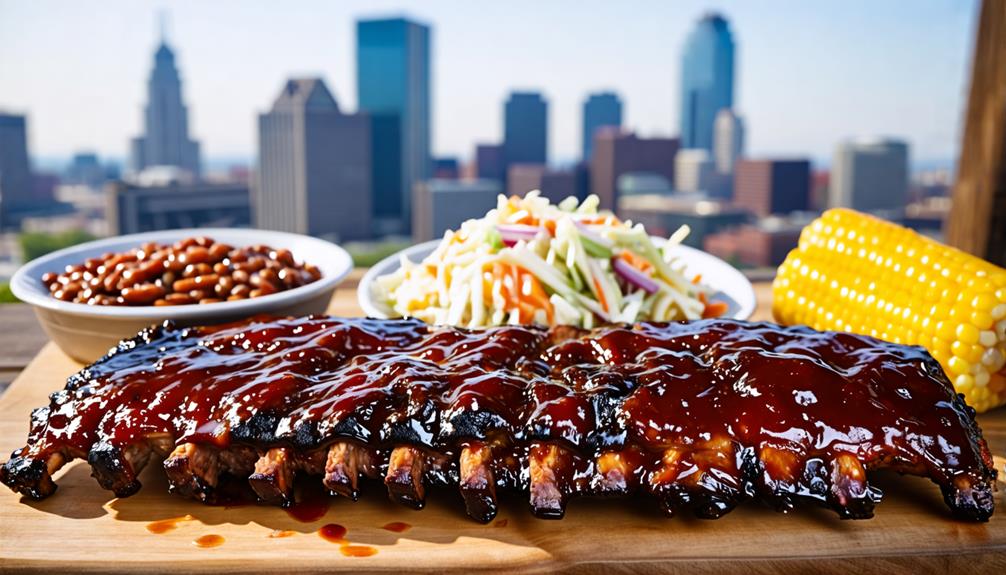Kansas City-style barbecue, born from the culinary innovations of Henry Perry in the early 20th century, offers a sensory delight that embodies the rich history of American barbecue.
This style is characterized by its slow-smoking process using hickory and oak woods, which imparts a deep, smoky essence to the meats.
The hallmark of Kansas City barbecue is its thick, molasses-based sauce, which complements the smokiness with its robust sweetness and a hint of tang from tomato, brown sugar, and apple cider vinegar.
The most favored meats such as brisket, pork ribs, and pulled pork are meticulously seasoned with a distinctive spice mix that enhances the natural flavors.
Embrace the tradition and learn how to recreate this iconic culinary experience in your own kitchen, connecting with a piece of American culinary heritage.
Key Takeaways
Kansas City BBQ is celebrated for its method of slow-cooking meats over a blend of hickory and oak woods, a technique that imparts a deep, smoky essence to the dishes. The hallmark of this regional style is its molasses-based sauces that combine the richness of tomato and brown sugar with the sharpness of apple cider vinegar, offering a complex, tangy flavor that is both rich and invigorating. Key spices such as smoked paprika, brown sugar, garlic and onion powders, along with chili powder, are meticulously blended to achieve a signature smoky-sweet flavor profile that is both robust and harmonious.
The meats most commonly associated with Kansas City BBQ include beef brisket, pork ribs, and pulled pork, each prepared with a patience that ensures they are tender and succulently juicy. Esteemed establishments like Joe's Kansas City, Arthur Bryant's, and Gates Bar-B-Q stand as pillars of the Kansas City BBQ tradition, each contributing to a rich culinary heritage that is both a source of local pride and a draw for visitors.
This style of barbeque not only satisfies the palate but also evokes a sense of communal identity and nostalgia, reinforcing the social fabric of Kansas City. The lingering sweetness of the sauces and the tender, smoky meats often evoke warm, familial gatherings, enhancing the communal and affective experience of dining. Such iconic eateries reflect the history and dedication to quality that Kansas City BBQ is known for, fostering a deep trust and loyalty among patrons.
History of Kansas City BBQ
The origins of Kansas City BBQ trace back to the early 20th century with Henry Perry, often regarded as the 'father of Kansas City barbecue.' Perry pioneered this culinary form by slow-cooking meats over a fire fueled by hickory and oak woods, imbuing the meat with a distinctive, smoky flavor that rapidly earned a devoted following.
As Kansas City became a cultural crossroads, its burgeoning BBQ scene was enriched by diverse culinary influences. Immigrants and migrants brought with them various cooking traditions, from African American to Southern styles, each weaving a unique strand into the city's barbecue fabric. This cultural confluence has been pivotal in defining the complex flavor profile that Kansas City barbecue is celebrated for today.
Perry's influence extended through his disciples, who went on to open their own BBQ joints, such as Arthur Bryant's and Gates Bar-B-Q. These establishments not only perpetuated but also evolved Perry's barbecue ethos, integrating their unique twists while staying true to the foundational techniques.
Thus, enjoying Kansas City BBQ is more than a mere culinary experience; it's a taste of a rich, historically layered tradition that mirrors a dynamic interplay of cultural contributions.
Key Ingredients
To excel in crafting Kansas City style barbeque, concentrate on three crucial components.
First, acquaint yourself with the quintessential BBQ spices that impart the unique, smoky-sweet flavor characteristic of this regional style.
Next, delve into the world of rich, molasses-based sauces that define Kansas City BBQ, enhancing the meat's flavor complexity.
Finally, selecting high-quality cuts of meat, such as brisket, ribs, and pork shoulders, is essential, as these are traditionally favored for their ability to absorb flavors and retain juiciness throughout the slow-cooking process.
This approach not only ensures a delicious outcome but also respects the cultural heritage and communal spirit deeply embedded in Kansas City's barbeque tradition.
Essential BBQ Spices
To excel in preparing Kansas City-style barbecue, a thorough grasp of essential BBQ spices is crucial, as they impart the distinctive, tantalizing flavor unique to this cuisine. The art lies in creating a well-balanced spice blend that permeates the meat with rich, smoky undertones complemented by sweet, savory, and spicy elements.
Start with paprika, a staple in BBQ rubs, which not only adds vibrant color but also an earthy base note. Opt for smoked paprika to introduce an added layer of smokiness. Incorporate brown sugar to enhance the sweetness and promote caramelization, essential for developing a crusty bark on the meat. Essential seasonings like salt and black pepper are indispensable for their flavor-enhancing properties and subtle heat.
Deepen the flavor profile with garlic and onion powders, and introduce a mild heat with chili powder. Mustard powder contributes a tangy sharpness, enhancing the overall complexity of the blend. For a distinctive edge, include ground cumin and a touch of cayenne pepper, which intensify the spices' dynamic range.
Thoroughly mix these ingredients and coat the meat generously, allowing sufficient time for the flavors to meld. This method lays the foundation for an authentic Kansas City-style barbecue, celebrating the regional tradition and the communal joy it brings to gatherings.
Through this culinary practice, not only is a delicious meal created, but also an atmosphere of warmth and camaraderie, resonating with the social and cultural fabric of barbecue.
Signature BBQ Sauces
Creating a signature Kansas City BBQ sauce involves a delicate balance of ingredients that meld sweet, tangy, and smoky flavors into a rich, cohesive blend. Begin with a tomato base, often ketchup, which provides both sweetness and a smooth texture. Enhance this sweetness with either molasses or brown sugar, adding a deep, caramel-like richness. Apple cider vinegar counters this sweetness, introducing a crisp tanginess that balances the sauce. Worcestershire sauce contributes complexity and a subtle umami flavor, enriching the overall taste profile. To infuse the quintessential smoky flavor, incorporate smoked paprika and a hint of liquid smoke.
Here is a breakdown of each ingredient and its function in the sauce:
| Ingredient | Role in Sauce |
|---|---|
| Ketchup | Provides base and sweetness |
| Molasses/Brown Sugar | Adds sweetness and thickness |
| Apple Cider Vinegar | Introduces tanginess |
| Worcestershire Sauce | Enhances depth and umami |
| Smoked Paprika | Infuses smoky flavor |
| Liquid Smoke | Amplifies smoky essence |
Kansas City BBQ sauce is versatile, complementing a range of meats such as ribs, brisket, and chicken. While Kansas City is famed for its sweet and tangy sauce, regional variations throughout the United States introduce diverse flavor profiles. Carolina BBQ sauces, for example, are typically vinegar-based, emphasizing tanginess, whereas Texas sauces often incorporate a spicier palette. Exploring different sauce and meat pairings can elevate your culinary expertise and delight your palate.
This guide not only provides practical instructions but also invites you to appreciate the cultural and regional nuances that define American BBQ, encouraging a deeper connection to the culinary traditions and innovations that shape our meals and gatherings.
Meat Selection Tips
When selecting meats for Kansas City BBQ, choose cuts that excel in slow cooking processes such as pork ribs, beef brisket, and chicken thighs. These cuts transform into succulent, tender delights after prolonged smoking, embodying the quintessential Kansas City taste.
Begin with pork ribs, ideally St. Louis-style for their balanced meat-to-fat ratio and uniform shape. This ensures even cooking and a rich flavor profile as the fat within the meat renders during the slow smoking process.
For beef brisket, prioritize a well-marbled cut. The fat marbled through the brisket melts gradually, maintaining the meat's moisture and infusing it with a smoky essence. Select a brisket with a consistent thickness and a pronounced point section, which are indicative of quality and will yield the best results.
Lastly, opt for chicken thighs over breasts. Thighs contain higher fat content, enabling them to remain moist and flavorful over extended cooking times. The robust taste of dark meat is a perfect match for the bold, sweet, and tangy nuances of Kansas City BBQ sauce.
These choices not only ensure a delightful eating experience but also reflect the traditional preferences and practices of Kansas City BBQ, promising authenticity and satisfaction.
Cooking Techniques
To master Kansas City-style barbecue, a meticulous approach to slow cooking at low temperatures using indirect heat is crucial. This process ensures that the meat remains moist and tender while infused with deep, smoky flavors characteristic of this regional cuisine.
Essential to this technique is the use of a smoker or a grill adapted for indirect heating, maintaining a steady temperature range of 225-250°F.
Selecting the right type of wood, such as hickory, oak, or applewood, is vital as it contributes a unique, aromatic smokiness that's quintessentially Kansas City. Positioning the meat away from direct heat and using a closed grill setup helps emulate the traditional smoking environment, promoting even cooking and flavor enhancement.
Incorporating a water pan within the grill or smoker is a strategic move. It introduces humidity, countering the drying effects of prolonged heat exposure and preserving the meat's juiciness.
Monitoring the meat's internal temperature with a reliable thermometer ensures it reaches the ideal doneness, reflecting a commitment to quality and respect for the cooking craft.
Signature Sauces
The essence of Kansas City-style barbecue is captured in its iconic sauces, which are characterized by a deep, tangy flavor with a hint of sweetness. These sauces set Kansas City's barbecue apart, making it a memorable culinary experience. Typically, these sauces blend a tomato base with either molasses or brown sugar to achieve their characteristic sweetness, balanced by a splash of vinegar and a mix of spices for just the right amount of tang and heat.
Kansas City barbecue sauces are remarkably versatile, enhancing a range of dishes without overshadowing the intrinsic smokiness of the meats. They're perfect for coating ribs, brisket, and pulled pork, and equally delightful on grilled chicken and sausages. Even side dishes such as fries and onion rings are transformed by these robust sauces.
Within Kansas City, variations of this classic sauce reflect the personal touches of local pitmasters who may adjust the levels of spice or sweetness to craft a unique flavor profile. Some innovators incorporate fruit-based elements like cherry or apple, introducing an unexpected and pleasing layer to the sauce's complexity.
This adaptability and distinctiveness not only cater to a broad spectrum of palates but also resonate with the communal and innovative spirit of Kansas City, making its barbecue a true staple in American culinary culture.
Popular Meats
Kansas City barbecue is celebrated for its expertly crafted beef brisket and succulent pulled pork. These meats are slow-cooked to achieve a tender texture and rich flavor that are hallmarks of the local culinary tradition.
This cooking style not only highlights the deep-rooted barbecue culture of Kansas City but also evokes a sense of communal pride and tradition.
The meticulous preparation of brisket and pork, infused with a blend of spices and smoked over selected woods, reflects a dedication to quality and authenticity that barbecue enthusiasts cherish.
Beef Brisket Mastery
Mastering beef brisket is a hallmark of Kansas City-style barbecue, renowned for its ability to tenderize a challenging cut through slow cooking and smoking.
Begin with the right rub—a hallmark of Kansas City's culinary identity, which typically blends sweet and savory elements such as brown sugar, paprika, garlic powder, and a subtle kick of cayenne. Thoroughly rub this mixture onto the brisket, allowing the spices to penetrate deeply and enhance the meat's flavor.
The smoking process is pivotal and demands patience. Heat your smoker to a steady 225°F and use a mix of hickory and oak woods to infuse the brisket with a distinctive, rich flavor. Position the brisket fat side up in the smoker; this technique allows the fat to render slowly, naturally basting the meat to maintain its moisture during the long smoking period. Expect to smoke the meat for about 1 to 1.5 hours per pound.
It's crucial not to hasten the cooking. The brisket should reach an internal temperature of approximately 195°F before it's removed from the smoker. Following this, wrap the brisket in butcher paper and let it rest for at least an hour. This crucial resting phase allows the juices to redistribute, ensuring the brisket is deliciously succulent and tender to the taste.
This method not only adheres to the traditional practices of Kansas City barbecue but also reflects a deep appreciation for the craft, promising a delectably smoked brisket that pulls apart with ease and melts in the mouth, leaving a lasting impression that epitomizes the spirit and flavor of the region.
Pulled Pork Perfection
To achieve the epitome of pulled pork, adhere to a method steeped in the traditions of Kansas City barbecue.
Begin by selecting a pork shoulder, also known as pork butt, which is prized for its fat marbling and ability to become exceptionally tender when cooked slowly.
Craft a rub that embodies the bold flavors typical of Kansas City: incorporate elements like paprika for smokiness, brown sugar for a hint of sweetness, garlic powder for depth, and a touch of cayenne for a subtle bite.
Thoroughly massage this mixture into the meat, covering every surface, and allow it to marinate for several hours, or ideally overnight, to fully infuse the flavors.
For smoking, choose woods like hickory or applewood that harmonize with the pork's natural flavors, maintaining a steady temperature of approximately 225°F.
The cooking process requires patience, generally lasting about 1.5 hours per pound, with the goal of reaching an internal temperature of 195°F.
This slow and careful cooking ensures that the meat is perfectly tender and easy to shred.
Key points for perfect pulled pork include:
- Selecting an appropriate cut of meat
- Using a rub that reflects Kansas City's rich barbecue culture
- Consistently managing the smoking temperature
These practices will guide you to master the art of Kansas City-style pulled pork, offering a culinary experience that's deeply satisfying and evocative of the region's barbecue legacy.
Famous BBQ Joints
Kansas City, renowned for its deep-rooted barbecue culture, offers a culinary journey through its iconic BBQ establishments, each presenting a unique narrative and flavor that epitomizes the city's gastronomic heritage.
Begin your exploration at Joe's Kansas City Bar-B-Que, originally a humble gas station, now celebrated nationally for its delectable burnt ends and succulent ribs. This spot not only serves exceptional barbecue but also reflects the transformative story of Kansas City's dining scene.
Continue to Arthur Bryant's Barbeque, a venerable institution steeped in decades of history. Known for its distinctive, rich sauce and tender brisket, Arthur Bryant's represents the soul of Kansas City barbecue, maintaining a loyal following through its consistent quality and authentic charm.
Experience the warm welcome of Gates Bar-B-Q, where the greeting 'Hi, may I help you?' embodies the congenial spirit of the city. Their mixed plate—a smorgasbord of ribs, juicy sausage, and more—offers a comprehensive taste of their culinary craftsmanship.
Lastly, visit Q39, where traditional barbecue meets contemporary creativity. This modern eatery stands out with its combination of chef-driven flair and smoked meats, paired innovatively with side dishes that enhance the overall dining experience.
These BBQ joints are more than mere eateries; they're cultural landmarks, serving as portals to Kansas City's rich culinary tradition and collective identity, celebrated at numerous BBQ festivals and cherished by both locals and visitors alike.
Side Dishes
When enjoying Kansas City-style barbecue, the accompanying side dishes are essential to enrich the meal.
Don't overlook the hearty classic bean recipe, the smooth, tangy coleslaw, and the inventive ways to serve cornbread.
These sides not only complement the rich, smoky flavors of the barbecue but also enhance the overall dining experience, bringing comfort and a sense of tradition to the table.
Each dish reflects a deep-rooted culinary heritage intrinsic to barbecue culture, adding layers of flavor and texture that are both satisfying and memorable.
Classic Beans Recipe
A quintessential accompaniment to Kansas City-style barbecue, this classic bean recipe delivers a rich, complementary flavor that enhances the smoky meats it's served with. Opt for pinto, kidney, or navy beans to provide varied textures and tastes that cater to personal preferences.
For a successful preparation of this beloved side dish, you'll need:
- Ingredients: Incorporate bacon, onions, brown sugar, molasses, and mustard for a robust base.
- Preparation: Soak dried beans overnight to ensure they cook to a tender consistency.
- Cooking Technique: Employ a slow cooker or a Dutch oven, allowing the beans to simmer slowly, which integrates the flavors deeply.
Serve these savory beans alongside your chosen barbecue dishes. The integration of sweet, smoky, and slightly tangy elements not only complements the main course but also continues a cherished Kansas City culinary tradition.
This recipe does more than fill a spot on your plate; it celebrates a rich cultural heritage and delivers a taste experience meant to be savored and revisited.
Creamy Coleslaw Tips
Creamy coleslaw is an indispensable accompaniment for a Kansas City-style barbecue, offering a refreshing crunch to balance the smoky flavors of the meats.
For an optimal coleslaw, start with fresh cabbage and carrots, finely shredded to ensure they're thoroughly coated with your dressing choice. You can opt for a classic, rich, mayo-based dressing or a lighter, zesty vinegar-based dressing.
Feel free to explore variations of coleslaw by incorporating red cabbage or apples for additional color and sweetness, or sliced jalapeños for a spicy kick. Integrating fresh herbs like cilantro or dill can enhance the flavor, making your coleslaw distinctively flavorful.
When preparing your coleslaw, mix the ingredients gently to maintain their natural crunch. Refrigerating the coleslaw for at least an hour before serving allows the flavors to blend seamlessly, ensuring the dish remains crisp and enhances your barbecue experience.
Cornbread Serving Ideas
Cornbread serves as an ideal complement to Kansas City-style barbecue, enhancing the meal with its sweet and savory profile that contrasts beautifully with the smoky flavors of the meats.
To elevate your dining experience, consider these inventive cornbread variations and toppings:
- Cheddar Jalapeño Cornbread: Infuse your cornbread with diced jalapeños and sharp cheddar cheese to introduce a spicy element that harmonizes with the robust flavors typical of Kansas City barbecue. This combination adds a lively zest and depth to your meal.
- Honey Butter Glaze: A drizzle of honey butter over warm cornbread introduces a note of sweetness, creating a delightful balance against the savory barbecue. This topping, a blend of honey and softened butter, is both simple to prepare and irresistibly delicious.
- Bacon and Scallion Cornbread: By incorporating crumbled crispy bacon and finely chopped scallions into your cornbread, you achieve a smoky, onion-tinged flavor that pairs exceptionally well with barbecued meats such as brisket or ribs.
These creative adaptations not only maintain the integrity and traditional appeal of cornbread as a side dish but also enhance the communal and comforting essence of a barbecue gathering.
Each variation and topping is designed to complement the main dishes typically enjoyed at such feasts, ensuring a cohesive and satisfying culinary experience.
BBQ Competitions
Kansas City BBQ competitions epitomize the intense and savory clash where pitmasters unveil their culinary artistry and guarded flavor formulas. Competitors battle fiercely, meticulously refining their meats to captivate the judges' palates. The evaluation criteria, emphasizing taste, tenderness, and visual appeal, demand precision in every aspect. Successful tactics typically involve precise timing of the cooking process, optimal temperature control, and selecting a variety of hardwoods to achieve a distinctive smoky essence.
However, the art of BBQ extends beyond mere cooking; presentation is equally crucial. It necessitates exact cutting, elegant arrangement, and ensuring the dish is visually tantalizing. Pitmasters may also use tasteful garnishes to subtly enhance the visual allure, ensuring they complement rather than dominate the dish.
Moreover, adaptability is essential in these contests. Unpredictable weather and potential equipment malfunctions require competitors to have contingency plans and remain flexible to maintain their edge.
These contests not only celebrate culinary excellence but also foster a sense of community and tradition, reinforcing the shared passion for BBQ craftsmanship.
Home Cooking Tips
Enhance your home BBQ by mastering the art of Kansas City-style barbecue with these essential tips.
Start by prioritizing safety: ensure your grill is stable and positioned on a non-flammable surface, and keep a fire extinguisher accessible to mitigate any risks. This setup helps maintain an even cooking temperature and ensures your safety.
Kansas City BBQ is celebrated for its harmonious blend of sweet, tangy, and smoky flavors. To replicate this, mix brown sugar and apple cider vinegar and smoke your meats using hickory or mesquite wood chips. This combination will infuse your dishes with the signature taste that makes Kansas City BBQ iconic.
Key techniques to perfect your grilling include:
- Preheat the Grill: Heating your grill for at least 15 minutes before cooking ensures a uniform cooking surface.
- Marinate Your Meats: Immersing your meats in marinade for at least four hours allows them to fully absorb the flavors, enriching the overall taste.
- Use Indirect Heat: For thicker cuts of meat, cook using indirect heat to avoid charring the outside while the inside remains uncooked.
Must-Try Recipes
Discover the heart and soul of Kansas City BBQ with these must-try recipes that promise to elevate your next cookout.
Begin with the classic Kansas City ribs, known for their depth of flavor and tender texture. Generously coat the ribs with a dry rub mixture of brown sugar, paprika, garlic powder, and a hint of cayenne to add a spicy kick. The key to achieving the quintessential smoky flavor lies in slow-cooking the ribs over indirect heat, a technique that requires patience but rewards with perfection.
Next, experience the renowned Kansas City burnt ends, a delicacy that embodies the spirit of the city's BBQ culture. Start by smoking a whole beef brisket to succulent perfection. Then, cube the point end of the brisket and coat these pieces in a rich, locally inspired BBQ sauce. Return them to the smoker until they achieve a perfect balance of crispy edges and tender centers, a texture that encapsulates the city's culinary craftsmanship.
Finally, don't overlook the pulled pork, a staple at any Kansas City BBQ gathering. Season a pork shoulder with a robust blend of spices and cook it low and slow to ensure it's fall-apart tender. Shred the cooked meat and douse it in a tangy, tomato-based Kansas City-style BBQ sauce, marrying the flavors to create a dish that resonates with both tradition and taste.
Each recipe not only brings the flavor of Kansas City to your table but also invites you to partake in a storied tradition of barbecue excellence, making your cookout an event to remember.
Frequently Asked Questions
What Are the Best Drinks to Pair With Kansas City Bbq?
When selecting beverages to accompany Kansas City BBQ, the rich, smoky flavors of the meat are best enhanced by certain drinks.
A bourbon-based cocktail such as an Old Fashioned is a classic choice, its robust and slightly sweet profile echoing the depth of BBQ sauces.
For those preferring non-alcoholic options, sweet tea or tangy lemonade are excellent choices; their refreshing and slightly acidic tastes provide a delightful contrast to the savory, often spicy BBQ dishes.
Additionally, exploring beer pairings can be rewarding—the crispness of a lager or the bitterness of a hoppy IPA can cut through the fat and complement the complex flavors of the BBQ, creating a harmonious dining experience.
How Does Kansas City BBQ Differ From Other Regional Styles?
Kansas City BBQ is renowned for its rich, sweet, and tangy tomato-based sauces, which are typically thicker due to the addition of molasses.
This style contrasts sharply with the vinegar-based sauces prevalent in Carolina BBQ or the emphasis on dry rubs found in Texas BBQ.
Kansas City's approach is characterized by a harmonious blend of sweetness and spice that caters to a wide range of palates, making it a beloved variant in the world of barbecue.
The method involves smoking a diverse array of meats, each generously slathered in sauce, creating a savory experience that resonates with the communal and celebratory spirit of American BBQ culture.
This style not only satisfies the taste buds but also evokes a sense of tradition and community, enhancing the overall dining experience.
Can Kansas City BBQ Be Made Vegan or Vegetarian?
Indeed, Kansas City BBQ can be adapted to fit vegan or vegetarian diets by substituting traditional meats with plant-based alternatives like jackfruit, tofu, or tempeh.
These substitutions effectively mimic the texture and absorb the rich, smoky flavors characteristic of BBQ when combined with vegan-compatible sauces and rubs.
This approach not only maintains the culinary essence of Kansas City BBQ but also aligns with ethical eating practices and environmental considerations, reflecting a growing societal shift towards plant-based diets.
Embracing these alternatives allows everyone to enjoy the communal and nostalgic experience of a BBQ, without compromising on taste or tradition.
What Is the Best Wood to Use for Smoking Kansas City Bbq?
Think of yourself as a chef-painter, where your smoker is your canvas, and the choice of wood is your palette of colors.
For crafting Kansas City BBQ, hickory and oak are the preferred types of wood, as they impart distinctive, deep flavors that resonate with barbeque enthusiasts.
Hickory, known for its bold, robust profile, lays down a foundation of hearty smokiness, reminiscent of a rustic autumn bonfire.
Oak, on the other hand, provides a more refined smoke, lending a smoother, steadier undertone to the meat, akin to the gentle touch of a watercolor brush on paper.
This careful selection of wood ensures your BBQ isn't just food, but a gastronomic portrait of flavor, celebrated and savored at every bite.
Are There Any Kansas City BBQ Festivals Worth Attending?
Certainly, Kansas City is renowned for its BBQ festivals that are essential for any barbecue enthusiast.
Notably, the American Royal World Series of Barbecue stands as the premier event, attracting top pitmasters who compete in rigorous contests, offering attendees a chance to savor exceptional barbecue samples.
Additionally, the Great American BBQ Festival is a highlight, combining live music and family-friendly activities with an array of exquisite barbecue offerings.
These festivals not only celebrate the culinary art of barbecue but also foster a sense of community and tradition, making them unmissable events for both locals and visitors alike.
Conclusion
Having experienced the distinct flavors of Kansas City BBQ, are you inspired to ignite your own grill?
Picture the rich sounds of sizzling meats and the enticing scents of deep, smoky sauces wafting through the air. This is your opportunity to not only explore a variety of side dishes but also to hone your BBQ techniques.
Consider taking it a step further—could your grilling prowess stand out in a BBQ competition? The only way to determine your culinary stature is to dive in.
So, why hesitate? Embark on this savory journey and master the art of Kansas City BBQ.







